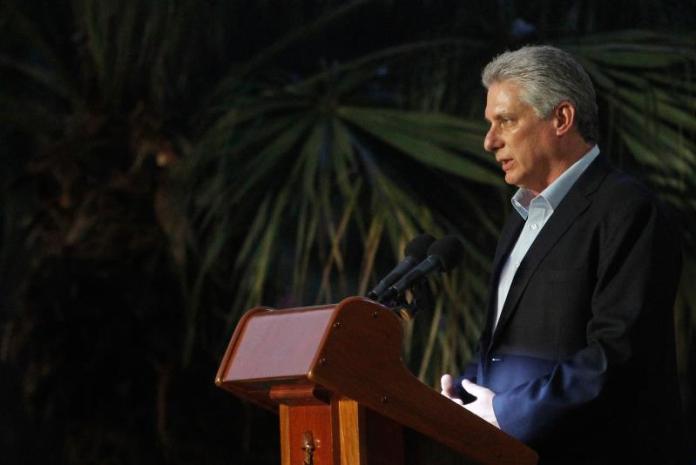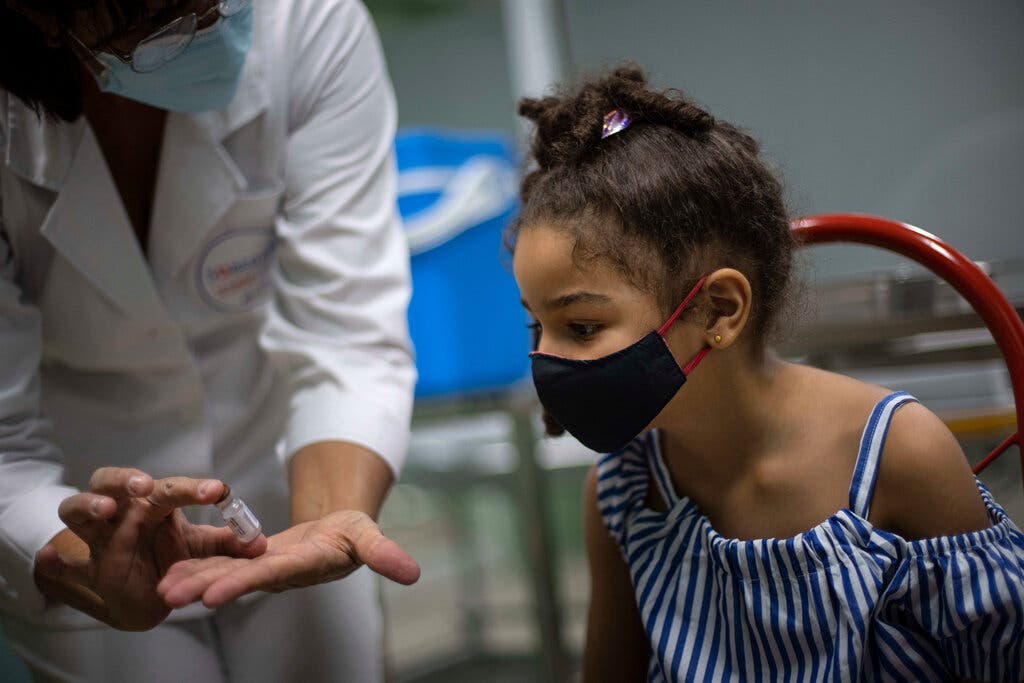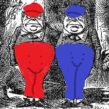2021, a difficult year, but Cuba scored points against Covid and the US blockade.
In his address to a Plenum of Cuba’s Communist Party on 16 December, Miguel Díaz-Canel characterized 2021 as “a year of victories for Cuba.”

Here’s what Díaz-Canel chalked up as the year’s successes:
The “protests”
First, the defeat of the attempts engineered in Washington and Miami to destabilize and ultimately overthrow the Cuban government and revolution. This they hoped to accomplish by exploiting discontent over Cuba’s economic difficulties, caused by the one-two punch of the US economic blockade and the Coronavirus pandemic. In July, during the worst spike of the Delta variant, they mounted a huge social media campaign to promote anti-government street demonstrations. Although much of the world capitalist press portrayed the 11 July demonstrations as massive, they were actually quite limited. In fact, they were dwarfed by pro-government demonstrations that took place in the following days. In all, perhaps a few thousand people turned out around the country for the “protests.” Many were curious or confused bystanders, not active participants. The organizers wanted to turn the demonstrations into confrontations with police and security forces. But when instigators began throwing rocks and bottles and overturning vehicles, most of those present dispersed. That left perhaps a few dozen, who achieved nothing beyond some vandalism and looting.

A few months later the sponsors of “J11,” as they had dubbed the July demonstrations, floated the idea of a “general strike.” But they soon abandoned that in favor of “N15,” another day of demonstrations to be held on 15 November. The capitalist world press, falling victim to its own propaganda and one-sided reporting, promoted “N15” as if it were Armageddon.
But thanks to Cuba’s massive vaccination campaign, by 15 November the country was well on its way to controlling COVID-19. By then the population also had a much better understanding of who the would-be protest organizers were and what they represented. “N15” simply didn’t happen; it was a non-event, a total flop. Nowhere did anyone come out to demonstrate. Yunior Garcia, chief spokesman for “N15,” unceremoniously fled to Spain, not bothering even to inform his handful of followers. There, he now basks in the capitalist media spotlight as a Cuba pundit.
Cuba’s Covid vaccines
As the country’s second victory, Díaz-Canel cited Cuba’s development of five COVID-19 vaccine candidates and the successful vaccination campaign conducted with three of those vaccines. By the end of November the campaign had taken Cuba to a position of world leadership in percentage of population fully vaccinated.

It was this successful vaccination campaign that made possible the other events Cuba’s president counted as victories:
- The reopening of the country’s borders, including the economically vital tourist sector.
- The reopening of the school system with the return to classroom instruction.
- The opening of the Havana Arts Biennial.
Real successes
The successes that Miguel Díaz-Canel cited are real, even though it’s too early to tell what the future holds for the fight against COVID-19. That, to paraphrase Yogi Berra, won’t be over until it’s over. And certainly, how the course of the pandemic evolves with Omicron or other variants will not only affect what happens with tourism, but with the recovery of the economy as a whole.
That being said, the Cuban president might have gone even farther.
Early in the pandemic the wealthy, so-called western democracies touted the COVAX program, which was supposed to guarantee equal access by “developing” countries to the vaccines produced by the multinational pharmaceutical corporations. Cuba bucked the tide and said “no thanks.” Instead, it opted to develop its own vaccines. That was no wild gamble or empty bluster. Despite the country’s relative poverty and 60-plus years of attempted economic strangulation by the United States, Cuba could boast an advanced pharmaceutical and biotechnology sector. It also had decades of experience in epidemiology, not only in Cuba, but in Africa, Asia, and Latin America. And it has a world-class community-based health care system. These were all achievements of the 1959 revolution that brought the 26th of July Movement to power and initiated the construction of a socialist society—under the most difficult conditions imaginable.
Nevertheless, enemies in the capitalist world portrayed Cuba’s decision to bypass COVAX as proof of the irresponsibility and incompetence of “the Cuban regime.” And when Cuba actually began vaccinating its population with not one, but three, of its vaccines, this same chorus of hyena voices trumpeted not the remarkable fact of the vaccines, but that they had not been approved by the World Health Organization (WHO).

What happened? Today, Cuba has one of the world’s highest vaccination rates (at this writing second only to the United Arab Emirates); COVID cases and especially deaths are dramatically lower than they were last summer. Meanwhile, in many of the countries that relied on COVAX, the percentage of those vaccinated is stuck in the low single digits. More than 90 countries failed to make the very modest goal of 40 percent vaccination by the end of 2021.[1] In Africa, batches of the mRNA vaccines produced by the multinationals and delivered through COVAX have had to be destroyed—hundreds of thousands of doses at a time. They are simply not suited to conditions in the Third World. Cuba’s vaccines, on the other hand, are based on proven protein-conjugate technology. It has been used for decades around the world in vaccines for meningitis and typhoid. These vaccines have relatively long shelf-life and can be stored in ordinary household refrigerators. The new high-tech mRNA vaccines slated for the COVAX program require special handling, fast delivery, and storage at subzero temperatures, conditions difficult if not impossible to manage in the Third World.[2]
[1] “World map shows which nations met 40% vaccine goal,” NPR, 30 December 2021 (https://www.npr.org/sections/goatsandsoda/2021/12/30/1068920127)
[2] “Cuba’s bet on home-grown COVID vaccines is paying off,” Nature, 22 November 2021 (https://www.nature.com/articles/d41586-021-03470-x; https://www.reuters.com/business/healthcare-pharmaceuticals/more-than-100-million-covid-19-vaccines-rejected-by-poorer-nations-dec-unicef-2022-01-13/)
Heading into 2022
Cuba’s decision to follow its own path to success, while much of the world’s population waited in vain for the capitalist West to deliver on its promises, has catapulted the island nation into a position of greatly enhanced prestige, not to say world leadership. That is an enormous victory. And as more countries approve use of Cuba’s vaccines and those vaccines come to their aid, the magnitude of that victory will continue to grow.
The US embargo/blockade is, of course, still in effect. It is naïve, if not delusional, to think it will end any time soon. Far from jettisoning their bankrupt Cold War policy, the powers-that-be in Washington want to launch a new Cold War. Their front men, the politicians, meanwhile, are locked into their never-ending internecine Punch-and-Judy show.

During the pandemic the blockade has weakened nonetheless, not through any wake-up or soul-searching in Washington, but through the solidarity of peoples and nations throughout the world who have rallied to Cuba’s aid. For 62 years the US has tried and failed to strangle and starve Cuba because it fears Cuba’s example. Now, that policy is backfiring. Given all the blockade runners, the failure of the policy is more evident every day. Cuba enters 2022 less isolated than at any time since the dissolution of the Soviet Union. That ranks as another victory.
In 2021, Cuba embarked on a difficult but necessary currency reform. At the same time it greatly expanded the range of opportunities for small and medium businesses outside the state sector. It will take time to smooth out the inevitable hiccups in implementing changes as sweeping as these. But simply to have put them in motion is victory—a victory over inertia.
Central planning, as opposed to reliance on the market forces of capitalism, has demonstrated its superiority in the campaign against Covid-19. But in an underdeveloped country such as Cuba, trying to advance toward a socialist society, centralized planning and state enterprises simply cannot meet all the needs of the population. The thousands of medium, small, and micro enterprises already legalized under the reforms, and those to come, will go a long way toward satisfying those needs. And they will draw upon the untapped creativity and genius of the Cuban people. So long as the workers’ and farmers’ government has its hands on the levers of the economy as a whole, and its eyes on the big picture, there is nothing to fear from these changes.
Challenges ahead
Yes, there are many challenges for Cuba in the year ahead. But Cuba is strong, and if it confronts them with creativity, flexibility, and sensitivity, all the while rooting out complacency and routinism, there will be more victories in 2022.
♦ ♦ ♦
For an in depth analysis of what happened in Cuba on 11 July 2021, and why, read Cuba—Whose Last Gasp?
Think the US is a democracy? You’ll think again when you read Exploding the Myth of American Democracy
[This is a test]

